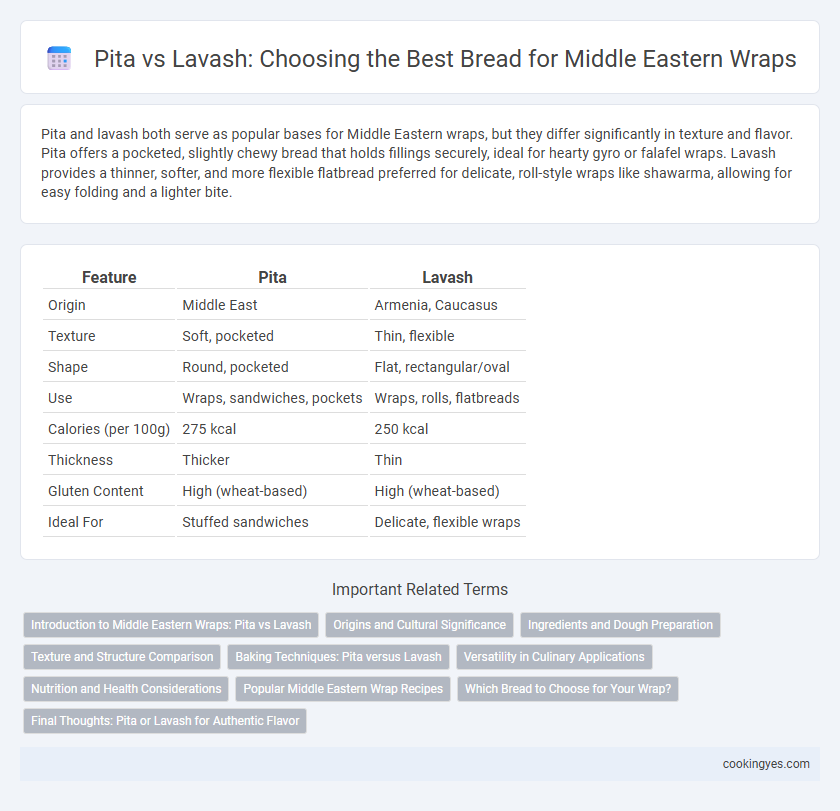Pita and lavash both serve as popular bases for Middle Eastern wraps, but they differ significantly in texture and flavor. Pita offers a pocketed, slightly chewy bread that holds fillings securely, ideal for hearty gyro or falafel wraps. Lavash provides a thinner, softer, and more flexible flatbread preferred for delicate, roll-style wraps like shawarma, allowing for easy folding and a lighter bite.
Table of Comparison
| Feature | Pita | Lavash |
|---|---|---|
| Origin | Middle East | Armenia, Caucasus |
| Texture | Soft, pocketed | Thin, flexible |
| Shape | Round, pocketed | Flat, rectangular/oval |
| Use | Wraps, sandwiches, pockets | Wraps, rolls, flatbreads |
| Calories (per 100g) | 275 kcal | 250 kcal |
| Thickness | Thicker | Thin |
| Gluten Content | High (wheat-based) | High (wheat-based) |
| Ideal For | Stuffed sandwiches | Delicate, flexible wraps |
Introduction to Middle Eastern Wraps: Pita vs Lavash
Middle Eastern wraps showcase diverse flatbreads with pita and lavash as prime examples. Pita, a soft, pocketed bread, holds fillings securely, making it ideal for hearty ingredients like falafel or shawarma. Lavash, thinner and flexible, creates delicate wraps perfect for lighter, fresh fillings such as grilled vegetables and herbs.
Origins and Cultural Significance
Pita bread, originating in the Levant region, is a staple in Middle Eastern cuisine known for its pocket that easily holds fillings, making it ideal for wraps like shawarma and falafel. Lavash, with roots in Armenian and Iranian cultures, is a thin, soft flatbread often used as a wrap or to scoop food, symbolizing communal dining and hospitality traditions. Both breads carry deep cultural significance, reflecting the diverse culinary heritage and social customs of the Middle Eastern and surrounding regions.
Ingredients and Dough Preparation
Pita and lavash breads use distinct ingredients and dough preparation methods that impact Middle Eastern wraps. Pita dough typically contains flour, water, yeast, salt, and olive oil, which is kneaded and allowed to rise before being baked at high heat to create a characteristic pocket. Lavash dough, made from flour, water, and salt without yeast, is rolled very thin and traditionally baked on a hot griddle or in a tandoor, resulting in a soft, flexible flatbread ideal for wrapping.
Texture and Structure Comparison
Pita features a thicker, pocketed texture that traps fillings securely, providing a soft yet sturdy structure ideal for juicy ingredients and dips. Lavash offers a thinner, flexible flatbread with a slightly crisp texture when baked fresh, allowing for tight rolling without added bulk. The denser composition of pita supports heavier fillings, whereas lavash's pliability excels in creating delicate, layered wraps.
Baking Techniques: Pita versus Lavash
Pita bread is baked at high temperatures, often exceeding 450degF, causing the dough to puff and create its characteristic pocket due to steam expansion. Lavash is traditionally cooked on a hot, convex metal griddle called a saj, resulting in thin, flexible bread without pockets, achieved by quick, direct heat exposure. The distinct baking methods influence texture, with pita's airy interior contrasting lavash's soft, pliable structure essential for Middle Eastern wraps.
Versatility in Culinary Applications
Pita offers greater versatility in culinary applications due to its pocket, which easily holds a variety of fillings like falafel, shawarma, and grilled vegetables, making it ideal for portable and handheld meals. Lavash, with its thin and flexible texture, excels as a wrap or flatbread for rolling around ingredients, often used for succulent kebabs and fresh herb wraps. Both breads are staples in Middle Eastern cuisine, but pita's unique pocket structure enhances its functionality across diverse dishes and serving styles.
Nutrition and Health Considerations
Pita and lavash, common Middle Eastern flatbreads, differ in nutritional content and health impacts, with pita generally offering higher fiber and protein due to whole wheat use, supporting better digestion and satiety. Lavash, often thinner and lower in calories, suits low-calorie diets but may lack sufficient fiber for optimal gut health. Choosing between pita and lavash depends on dietary needs, emphasizing fiber-rich pita for heart health and blood sugar regulation or lavash for calorie-controlled meal planning.
Popular Middle Eastern Wrap Recipes
Pita and lavash are both popular Middle Eastern flatbreads used in traditional wrap recipes such as shawarma, falafel, and kebabs. Pita's pocket structure allows for easy stuffing with ingredients like grilled meats, fresh vegetables, and tahini sauce, making it a versatile choice for hearty wraps. Lavash offers a thinner, softer texture that can be rolled tightly for wraps like Armenian lavash rolls or Iranian jujeh kebabs, providing a lighter, more pliable alternative.
Which Bread to Choose for Your Wrap?
Pita offers a pocket that easily holds fillings, making it ideal for neatly packed Middle Eastern wraps, while lavash provides a thinner, flexible flatbread perfect for tightly rolled wraps with varied ingredients. Choosing pita enhances the convenience of eating and portion control, whereas lavash's larger surface area allows for more filling and creative wrap styles. Consider your preference for sandwich-style versus rolled wraps when selecting between these traditional breads.
Final Thoughts: Pita or Lavash for Authentic Flavor
Pita and lavash both offer unique textures and flavors crucial to authentic Middle Eastern wraps, with pita's soft, pocketed bread ideal for holding fillings securely, while lavash provides a thinner, flexible wrap enhancing the overall tenderness. The choice between pita and lavash depends on regional preferences and the specific type of wrap, with pita commonly favored in Levantine dishes and lavash more prevalent in Armenian and Persian cuisines. Selecting the right bread ensures an authentic flavor experience that reflects the cultural heritage of Middle Eastern culinary traditions.
Pita vs Lavash for Middle Eastern wraps Infographic

 cookingyes.com
cookingyes.com